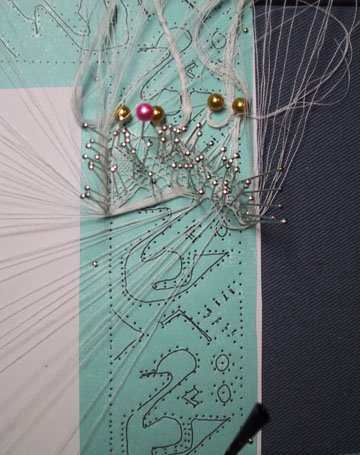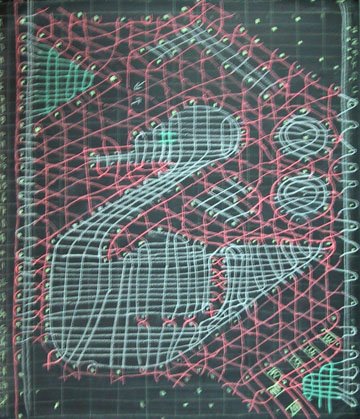When you being to wonder what people do with their lace, and envision little doilies all over the furniture and hankies in the drawer, look a little further. There is a wonderful contemporary implementation of lace created by Joep Verhoeven. It's the most beautiful chain link fence I've ever seen.
Of course, there are jewelry interpretations of lace. Gloria Valli's site shows her contemporary jewelry. There are also other "wearables" which the modest might not endeavor to don, but I wouldn't be too surprised to see on a runway model.
There are also people who are doing more classic designs in contemporary jewelry form, such as Susan Lambiris whose site illustrates some of her work. She's working in Flanders, point ground and other lace techniques to create some really beautiful jewelry.
Set your preconceptions aside, and imagine how you might develop your own contemporary interpretation of lace.
Sunday, December 04, 2005
Friday, October 14, 2005
Polychrome de Courseulles
Polychrome de Courseulles is a French lace originating from the Normandy coast in France. It appears around 1896, around the time that Chantilly lace (a black silk lace) was popular.
Polychrome is a silk lace, made with a very fine highly twisted ground thread and multi-colored threads in the decorative areas. The ground thread is usually a blonde color (a natural slightly off-white color), or black. The colored threads are usually not twisted very tightly, and often are strands of multiple colors, creating a combined color.
There are few books available on this lace. Claudette and Michel Bouvot are the primary authors. Dentelles Normandes - Polychrome de Courseulles(2001) is out of print; it is in French with a separate English translation. Polychrome de Courseulles - 9 Modeles (2004) is still available, as is Dentelle Polychrome de Courseulles sur la Route des Dentelles Normandes (the latter by Jean-Claude Brulet).
For anyone who is a fan of color, this is a lovely lace to see and make. Some samples can be seen at http://blondecaen.chez-alice.fr/esom.htm
Polychrome is a silk lace, made with a very fine highly twisted ground thread and multi-colored threads in the decorative areas. The ground thread is usually a blonde color (a natural slightly off-white color), or black. The colored threads are usually not twisted very tightly, and often are strands of multiple colors, creating a combined color.
There are few books available on this lace. Claudette and Michel Bouvot are the primary authors. Dentelles Normandes - Polychrome de Courseulles(2001) is out of print; it is in French with a separate English translation. Polychrome de Courseulles - 9 Modeles (2004) is still available, as is Dentelle Polychrome de Courseulles sur la Route des Dentelles Normandes (the latter by Jean-Claude Brulet).
For anyone who is a fan of color, this is a lovely lace to see and make. Some samples can be seen at http://blondecaen.chez-alice.fr/esom.htm
Monday, June 27, 2005
Making your own block lacemaking pillow
More good stuff from this Australian site http://www.brandis.com.au/craft/lace/block.html - how to make your own block pillow. It's an inexpensive way to get a block pillow to get you started on making lace!
Making paper bobbins for bobbin lace
There are many ways to do things for lacemaking, and this site http://www.brandis.com.au/craft/lace/bobbin.html has an approach for making bobbins from paper, bamboo skewers and beads. Inexpensive, ingenious, and fun for those who like to do such things.
Sunday, May 22, 2005
Stuart King bobbin making page
This page has some interesting basics about bobbins. Stuart King is an interesting craftsman; he provides additional information about himself and his craft as well as the part about bobbins.
Stuart King bobbin making
Stuart King bobbin making
Saturday, April 30, 2005
Learning how to make bobbin lace
There are a number of ways to learn about making bobbin lace. The initial steps are not terribly difficult, but they require a few specialty items, and some patience. Here are some resources for a newbie to check into:
Lacemaking instructional booksThere are quite a few books on the market about lacemaking. Many are in print, and are available from lacemaking suppliers, or even on places like amazon.com. Out of print ones appear occasionally on eBay, or show up in used bookstores (try places like abebooks.com).
Lacemaking suppliers
Suppliers are plentiful in some places such as England, but they are rarities in other countries. The US has a number of suppliers, as does Australia, Holland, and Belgium. Try doing a Google search on lacemaking supplies or lacemaking bobbins, and you may find some. Some appear as links off of the pages that are listed as resources on this blog.
Lacemaking videos
Some videos and DVDs have been produced. These are often available from lacemaking vendors. There are some videos on YouTube that are certainly worth a look. In addition, Jo Edkins has compiled an impressive online Bobbin Lace school.
WorkshopsWorkshops are offered in various countries. It is not uncommon to find a lace teacher from Europe teaching in the US, or vice versa. To find out about lace workshops being offered, check into sites of lacemaking instructors, lacemaking magazines, or lacemaking guilds.
Lacemaking guildsGuilds often have various activities going on, some of which may include some form of instruction. This is also the most probable place to find someone who is offering a weekly lacemaking class.
Lacemaking instructional booksThere are quite a few books on the market about lacemaking. Many are in print, and are available from lacemaking suppliers, or even on places like amazon.com. Out of print ones appear occasionally on eBay, or show up in used bookstores (try places like abebooks.com).
Lacemaking suppliers
Suppliers are plentiful in some places such as England, but they are rarities in other countries. The US has a number of suppliers, as does Australia, Holland, and Belgium. Try doing a Google search on lacemaking supplies or lacemaking bobbins, and you may find some. Some appear as links off of the pages that are listed as resources on this blog.
Lacemaking videos
Some videos and DVDs have been produced. These are often available from lacemaking vendors. There are some videos on YouTube that are certainly worth a look. In addition, Jo Edkins has compiled an impressive online Bobbin Lace school.
WorkshopsWorkshops are offered in various countries. It is not uncommon to find a lace teacher from Europe teaching in the US, or vice versa. To find out about lace workshops being offered, check into sites of lacemaking instructors, lacemaking magazines, or lacemaking guilds.
Lacemaking guildsGuilds often have various activities going on, some of which may include some form of instruction. This is also the most probable place to find someone who is offering a weekly lacemaking class.
Saturday, April 23, 2005
Bobbin lace - what is it?
Bobbin lace is an art that dates back to the mid 1500s (there is debate as to the actual starting date and location). It is thought to have started in Europe as a mechanism for creating fine lace without needing a weaver. You see, bobbin lace is woven. Unlike tatting, which is knotted. Or knitted or crocheted laces that are looped. Before this technique was developed, weavers wove fabrics, and needleworkers used various methods to create decorative holes in the fabric.
This photo shows bobbin lace in progress. It is made on a lacemaking pillow, which is stiff enough to hold the pins securely. The threads are wound onto bobbins, which are then used to manipulate the threads. The pricking is the pattern, which indicates where to put the pins. The pins are inserted after one or more stitches are made using the bobbins. As the work progresses forward, the pins are left in the most recent inch or so of the lace to prevent the tensioning process from pulling the stitches out.
This photo shows bobbin lace in progress. It is made on a lacemaking pillow, which is stiff enough to hold the pins securely. The threads are wound onto bobbins, which are then used to manipulate the threads. The pricking is the pattern, which indicates where to put the pins. The pins are inserted after one or more stitches are made using the bobbins. As the work progresses forward, the pins are left in the most recent inch or so of the lace to prevent the tensioning process from pulling the stitches out.
Subscribe to:
Posts (Atom)



